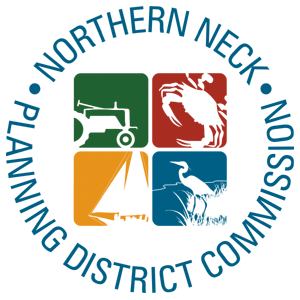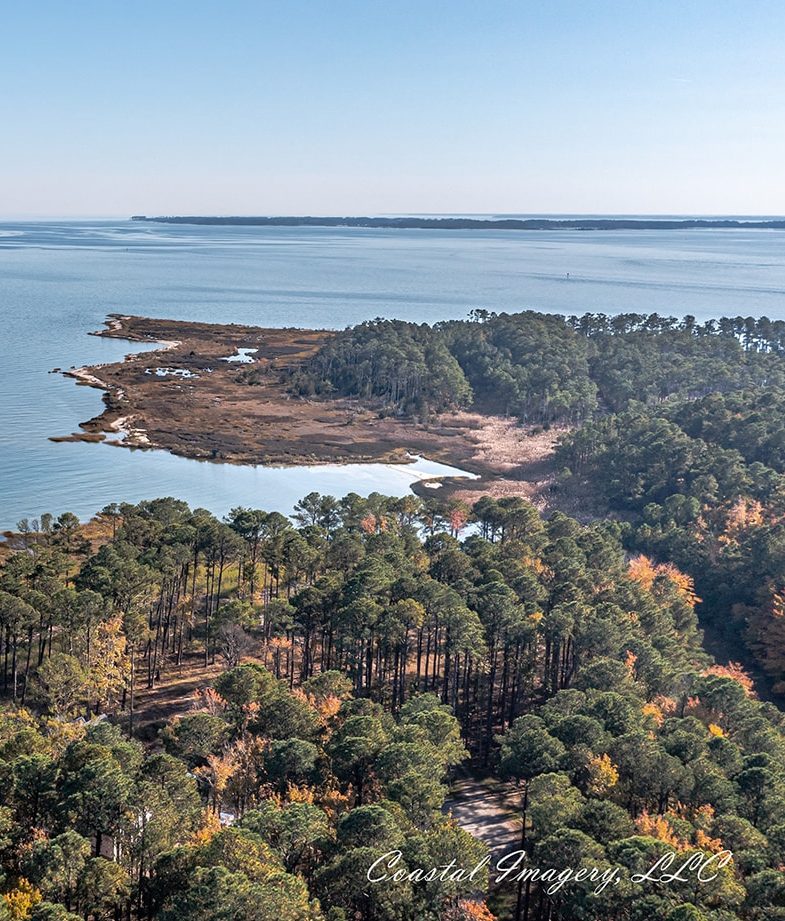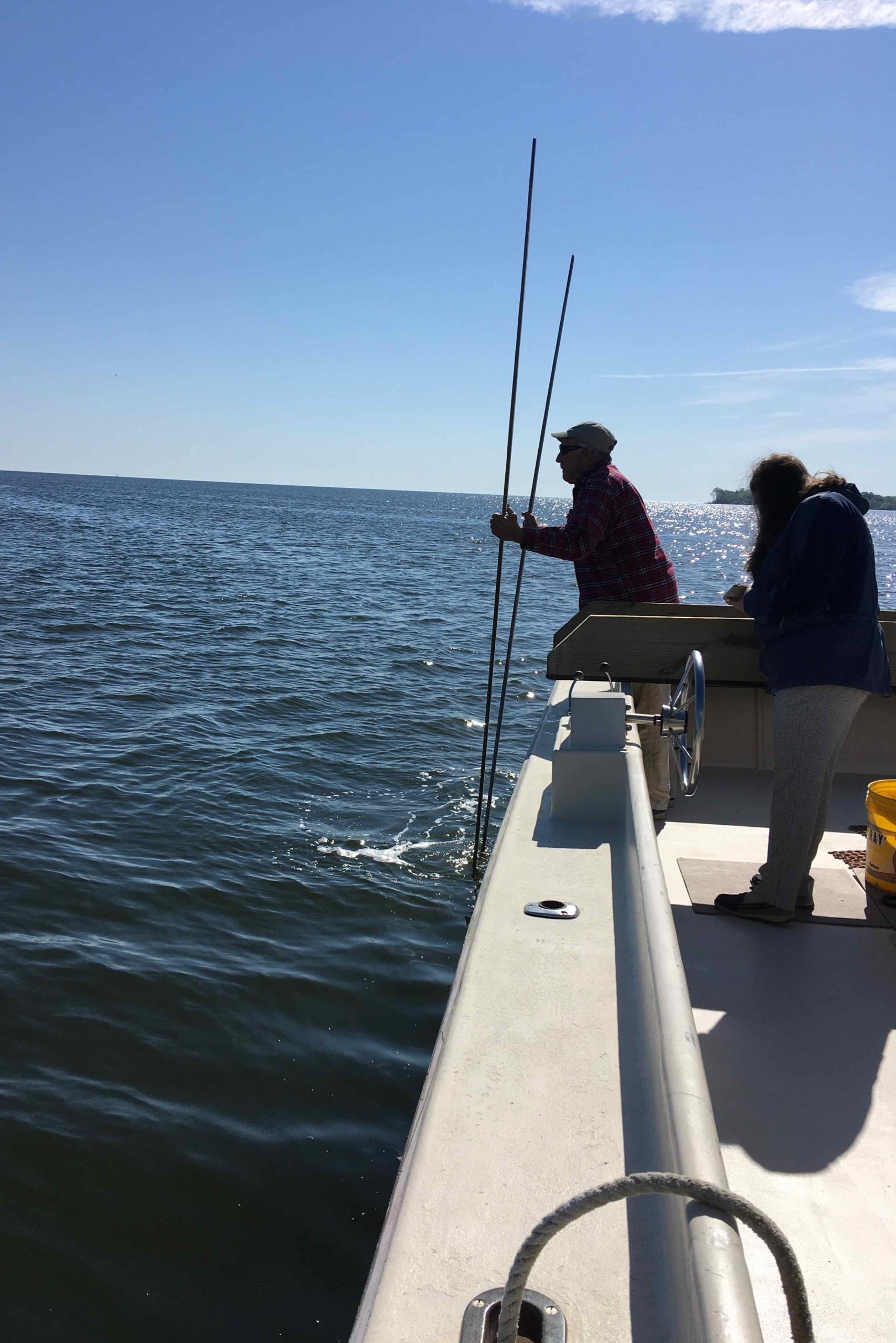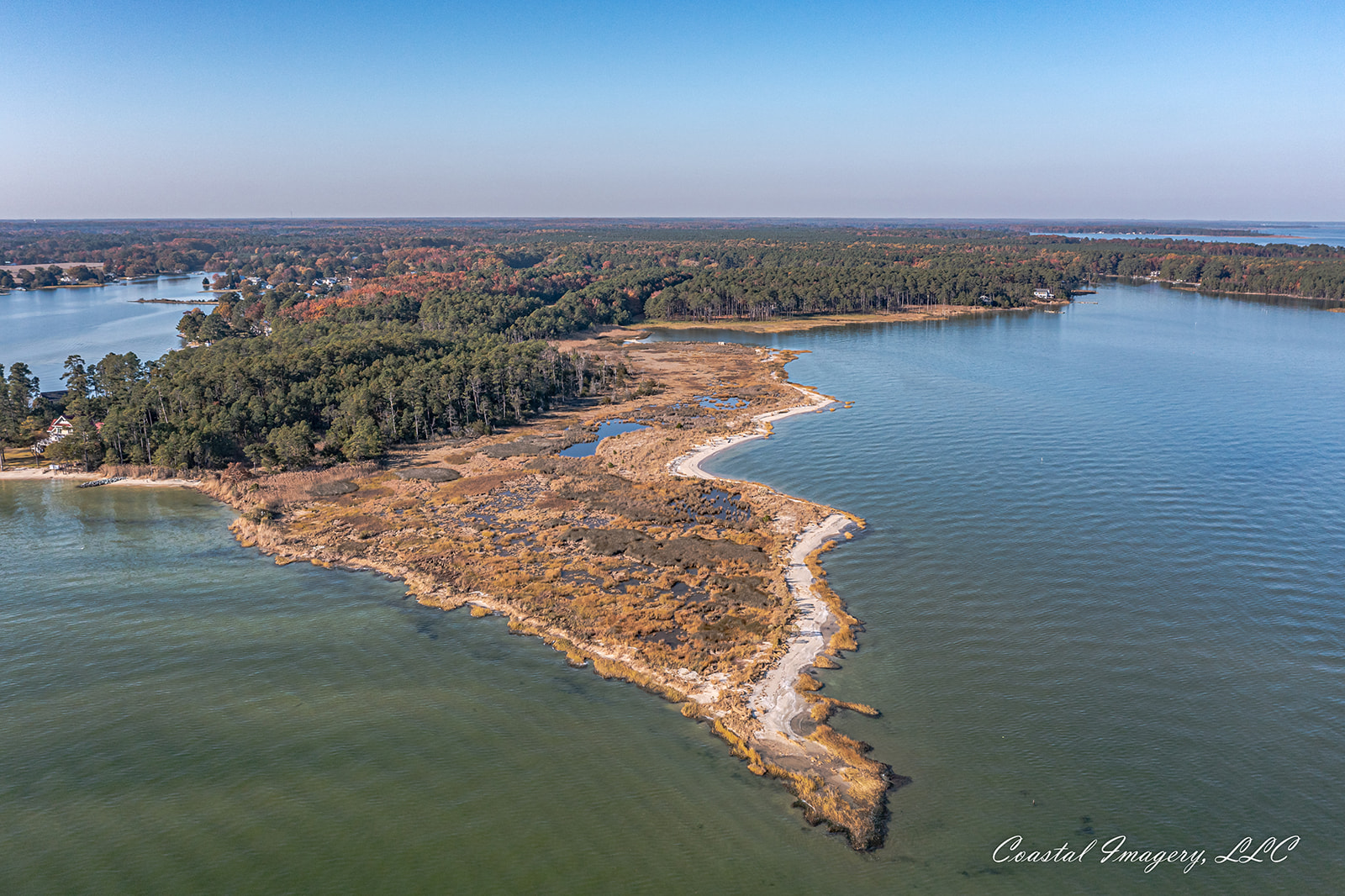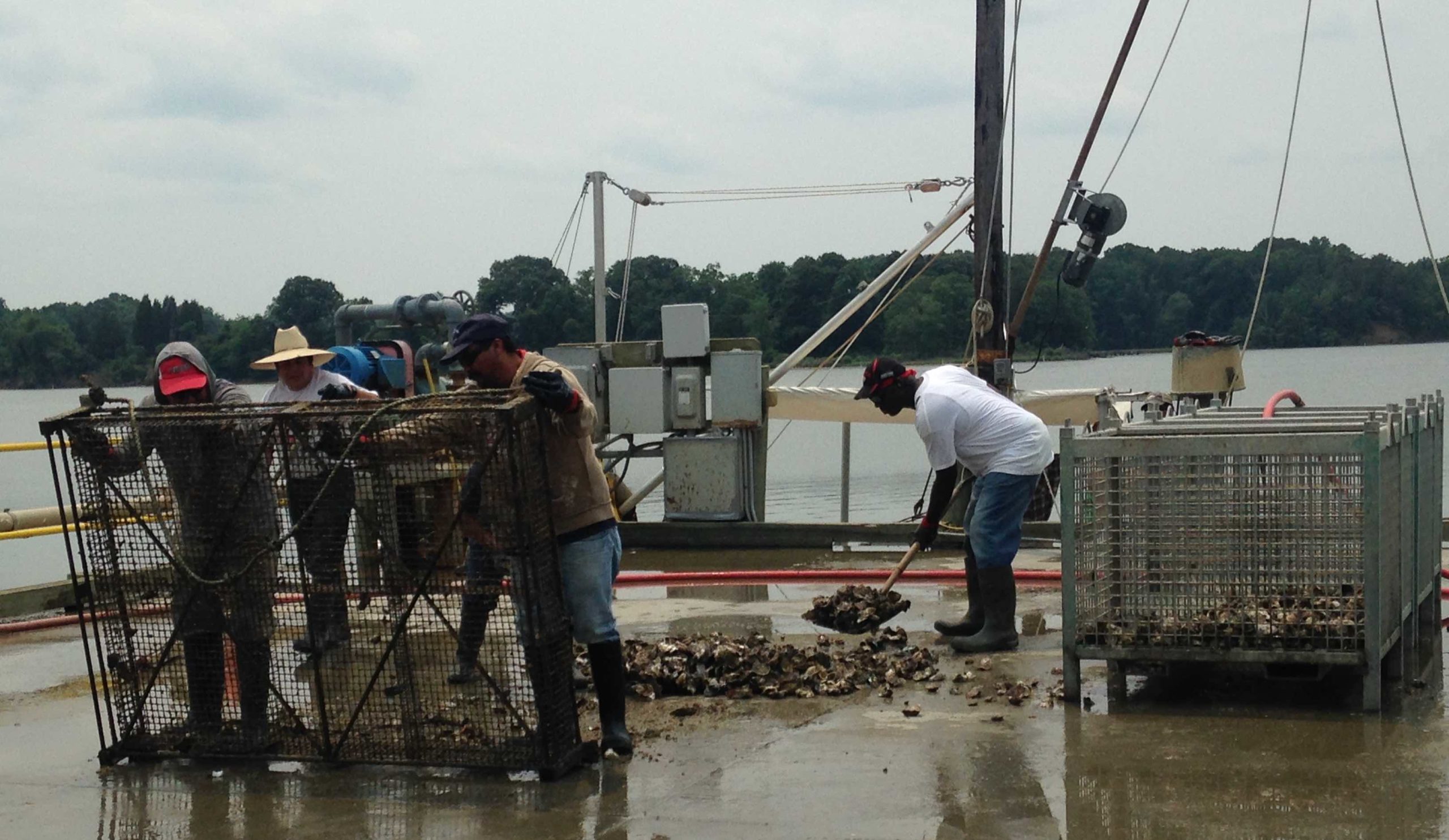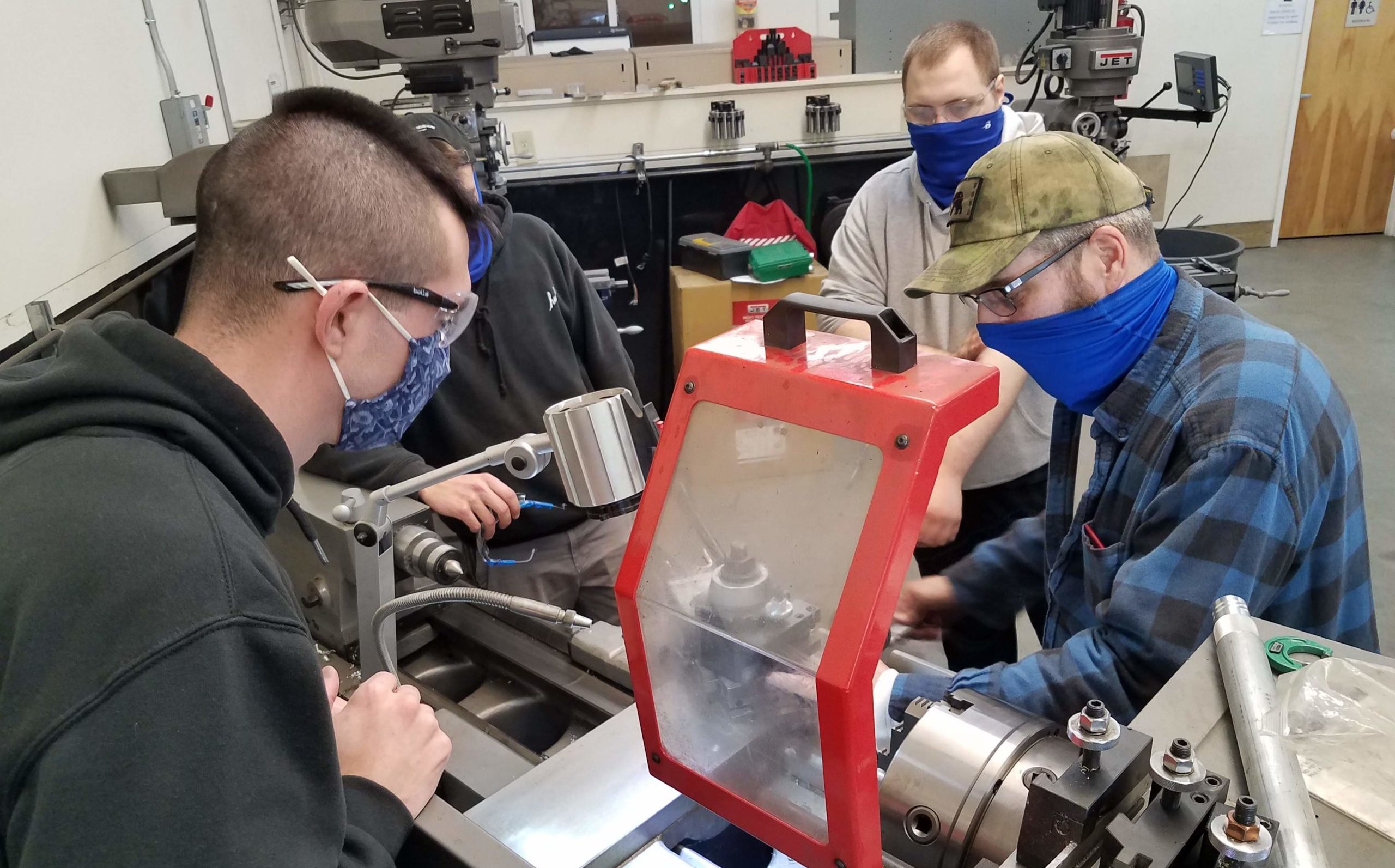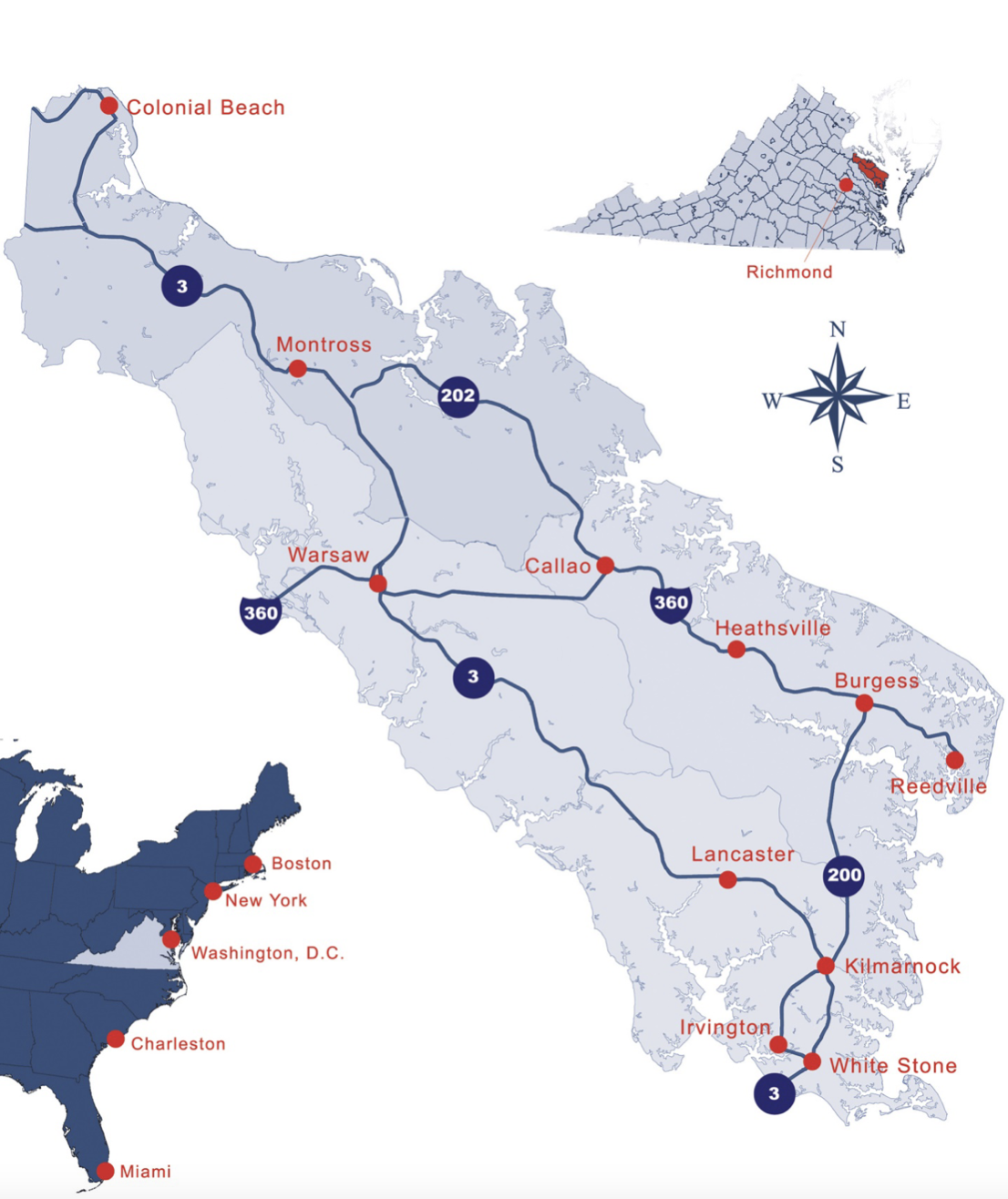SWOT ANALYSIS
ANALYSIS:
OPPORTUNITIES AND THREATS
While there are a number of opportunities that are worth pursuing, several stand out for prioritization.
REMOTE WORK
An outgrowth of the pandemic is the rising popularity of remote work. For twenty years, the growth of relatively remote communities has been spurred by entrepreneurs escaping from the big cities to run their businesses via computer and cell phone. As this way of doing business gains traction among more companies large and small, the opportunities expand exponentially for workers in more rural communities that may have low visibility but offer a high quality of life. These communities have seen an influx of people and businesses who find they can function effectively in beautiful places, far from the hustle and bustle of big cities.
The Northern Neck boasts a natural beauty, quality of life and a palpable warmth that has attracted people from all over the east coast both before, and especially during the pandemic. The Northern Neck’s remote work/unique value proposition is the combination of its mid-Atlantic waterfront location and its relatively close proximity to Washington, DC, Richmond and Norfolk, now soon to be augmented by an increasing quality and availability of broadband. These factors create a competitive advantage for the region.
Expanding options for remote work influence the local economic environment via the ability to attract more businesses who are now comfortable conducting their affairs online, and the ability to offer remote workers an expanded area in which they can settle in the region. This evolution in doing business is attractive to workers and offers an expanded palette of job opportunities for those already living in the region. This may encourage more young people to remain in the Northern Neck after graduating from school and may bring back former residents and alumni to raise their families in the region they once called home. It also reduces the potential disadvantages to newly locating workers and families, who now may be able to keep their jobs or find new ones anywhere in the world.
WORKFORCE DEVELOPMENT
Workforce Limitations
There exists a double opportunity/threat posed by limitations on available workforce. Three out of every four businesses interviewed noted that a lack of skilled workers was a major constraint to their growth. Companies in various industries such as timber, manufacturing, tourism, and aquaculture were ready to expand, but were unable to find a sufficient workforce.
Respondents shared one of two schools of thought in this regard: some felt that there was just a scarcity of people with the skills needed in their industry, while others observed a shortage of workforce in general. With populations that are relatively stagnant or shrinking, the challenge is to enhance the skills of the existing workforce to meet the needs of local employers.
Business owners and managers cited a lack of people with the skills to run sawmill saws, work on diesel engines, or a lack of basic computer skills. As part of a companion project that reviewed the workforce pipeline, numerous interviews were conducted with Rappahannock Community College (RCC) leaders, other trainers, workforce development officials and employers. Positions requiring a variety of skill sets were identified as needed but largely unfilled at businesses in the region. However, most of those skills were included in the course curricula at RCC. It became apparent that by increasing communication between employers and trainers, the existing workforce in the area could be optimized. Recently, several new approaches were initiated to increase coordination and cooperation between employers with available jobs and workforce training professionals. These efforts should be helpful in preparing young workers for real jobs, as well as for reskilling or upskilling workers who lost their jobs during the pandemic.
However, increasing communication and improving training opportunities will likely not be enough to satisfy the needs of frustrated business owners who feel that the workforce will still be too small to meet their needs. To retain, expand and attract businesses to the Northern Neck, it will be essential to create and implement a strong strategy to attract new people to the region and to reclaim workers who left the region.
Workforce, despite the current shortages, is also a topic loaded with possibilities. Remote work may offer new opportunities for high paying jobs from outside the region to be available to Northern Neck working residents and could sweeten the “quality of life” incentive, drawing more workers and their families to the Northern Neck. However, there is much more that can be done to optimize the existing workforce while ensuring that employer needs are met.
The Role of Workforce Education and Training
The existence of multiple locations for Rappahannock Community College at sites in Gloucester, Richmond, Lancaster, King George, and New Kent Counties presents a tremendous resource for economic development. The college offers programs that address needs in the manufacturing, aquaculture, timber, tourism, and other industries native to the Northern Neck, and is in the process of diversifying its course offerings. Addressing the issue of skilled worker shortages more effectively will create an opportunity to fuel growth in the regional economy.
The Role of Communication
There is a high level of commitment by RCC to meeting community needs and serving the employers of the region, with whom gainful employment could be found for RCC graduates. Most encouraging is the fact that every employer interviewed who had any experience working with RCC gave the college very high marks in meeting their employment needs. What seemed most limiting to RCC’s ability to train students for jobs in the region appeared to be a lack of ongoing communication with employers regarding their needs. Many employers did not realize that the college was already training students in the job skills they needed to hire and maintain their workforce. No blame was placed either on the college or on the employers, but clearly, there is a need to promote closer and more routine communication between trainers and employers. Where appropriate training exists, employers may find real prospects for hiring and where that training might not yet exist, the leaders of RCC are eager to find ways to meet the needs of those employers, as feasible.
The Bay Consortium Workforce Development Board, which serves as the regional Workforce Development Board (WDB), working in conjunction with the Northern Neck Planning District Commission (NNPDC) has recently taken on two ways of bringing employers and trainers (including RCC) together. The WDB has a monthly Business Services meeting that is well attended by RCC and other training groups in the region and has launched a campaign to attract employers to attend to hear what is available, and to make their needs more widely known.
This monthly venue has been supplemented by a series of industry roundtables conducted this past Spring and early Summer, hosted by the WDB, and co-hosted by the NNPDC. Each roundtable featured presentations by local employers, followed by discussion with RCC representatives and economic developers. In-person/Zoom hybrid industry roundtables were held for tourism, aquaculture/agriculture, marine industries/marinas, healthcare, technology firms, and manufacturing. The dialog was most enlightening and several of the attending businesses are already collaborating more closely with RCC.
List of Key Industries in the Northern Neck
/need for skilled workers
- Aquaculture
- Agriculture
- Marina Management
- Manufacturing
- Timber and Wood Products
- Tourism and Hospitality
- Construction Trades
- Nursing
- Food Processing
- IT and Cybersecurity
- Research and Development
- CDL
We predict that matching of trained workers with employers’ needs will ramp up soon and, as RCC graduates find employment, word will spread that relevant coursework can help individuals find a good job. In the past, the lack of an obvious close connection between training and employment has sometimes led to needed courses failing to generate sufficient enrollment to continue offering them. By creating more awareness, there is an opportunity to optimize workforce resources, help employers thrive and grow, and attract more young people back into the region’s workforce.
That brings us to the other aspect of workforce challenges: the lack of enough people of working age to build an adequate workforce to meet business needs.
Workforce Growth
The quality of life in the Northern Neck currently attracts those who want to relocate from area cities to the region. In addition, the Northern Neck needs more working age people to fill the workforce gaps and reduce the average age of the overall population. The region has a rich offering for families and workers, but it will require an aggressive promotional effort to get the word out and to incentivize workers to relocate to the region. One idea would be to model a campaign like what has been accomplished in other small communities all over the country; creating and implementing a regional “come back home” campaign targeting emigrating young people. Incentives such as cash payments, payment of moving costs, assistance with finding and purchasing homes and help with finding jobs for spouses may be considered to help encourage this return home.
It will be important for the Northern Neck to find ways to retain and attract workers to supplement the workforce numbers. Once again, this can be turned into an opportunity if action is taken. The growth of local firms, their willingness to train and promote workers and the lure of rejoining family and friends can be a strong pull for former residents, as well as an attractive package. However, it is important for the Northern Neck to expand its available workforce if businesses are to grow and remain viable in the region.
HAZARD MITIGATION
One possible deterrent to people locating or relocating to the Northern Neck could be the susceptibility of a region surrounded on three sides by water to flooding and other natural disasters. The Northern Neck Hazard Mitigation Plan, updated in 2017, listed several natural threats, mostly tied to water. These included flooding, as well as hurricanes, tornadoes, coastal erosion, winter storms, drought, wildfires, and earthquakes.
In their revised plan for 2017-2020, the federal emergency management agency (FEMA) and the Virginia Department of Emergency Management, recommended several approaches to ameliorate the impact of these natural threats, including land acquisition, floodplain protection, watershed management, beach and dune preservation, riparian buffers, forest and vegetation management, erosion and sediment control, wetland preservation and restoration, habitat preservation, slope stabilization and protection of historic and archaeological sites.
The report cited the importance of the Northern Neck’s assets to industry and tourism, suggesting an aggressive program of education, infrastructure development and hazard awareness.
TOURISM
Tourism has been an important contributor to the regional economy and continues to be an area with great potential. Unfortunately, this industry, while stable, has also been relatively flat. With the natural and human resources available in the Northern Neck, prior to the pandemic, travel and tourism seemed likely to have been growing. However, the industry, which includes accommodations, recreation, and food services, has shown minimal growth in the three years leading up to the COVID-19 crisis. It has also lagged behind state growth data in tourism-related expenditures, payroll, employment, taxes collected and the overall number of tourism-related businesses.
This data did not surprise most of the tourism industry people who were interviewed, and they almost unanimously believe that there is room for improvement. Factors that may be limiting optimization of this essential industry include shortages of workers, somewhat limited access to the region, relatively scarce access to the waterfront, a shortage of available accommodations, and relatively little budget for regional marketing.
In the Regional Tourism Plan 2019 to 2023 provided by the Northern Neck Tourism Commission, visits by tourists and travelers proved to be a popular and viable way to grow the local economy. It was found that tourists tend to come to the region more than once per year, roughly half have six figure incomes, and they tend to prefer extended stays.
However, more product development and marketing are cited as necessary to optimize this resource. More hotel rooms were cited as a need, as were the need for a consistent brand, regional cooperation, more water access infrastructure upgrades and more marketing dollars spent on tourism.
The region is looking to the development of Longwood Hull Springs as a destination that could accommodate groups in a small meetings setting and provide a location for a commercial kitchen and culinary arts training. Expanding the footprint of a 4-year university in the region will stimulate research crosswalks between K-12 students, especially the Chesapeake Bay Governor’s School, and generate local internships in marine and environmental studies.
WATER ACCESS
Given that the Northern Neck is surrounded by water (Chesapeake Bay, and the Potomac and Rappahannock Rivers), lack of public access to the water is driven by private waterfront acquisition for homes, and steadily rising prices of waterfront property. The counties should be encouraged to increase and enhance public waterfront amenities, as 47% of residents see public water access as one of the area’s ‘Most-Needed Outdoor Recreation Opportunities’, according to the 2018 Virginia Outdoors Plan. The NNPDC has joined with other coastal PDCs in an effort to promote water trails around the Chesapeake Bay and its tributaries for paddling through a website: virginiawatertrails.org.
NATIONAL HERITAGE AREA DESIGNATION
One reason for optimism about recovery and growth for tourism in the region is the recent Congressional action on designating the region as a National Heritage Area. In June, companion bills were introduced in the House and Senate that would finalize the designation of the Northern Neck as the Northern Neck National Heritage Area and would be a major asset to the region. Prospects are good for passage in both houses, with bipartisan support at the point of introduction. A feasibility study conducted by the National Park Service qualified the region as a national heritage site; Congressional passage is the last step in the process.
According to a press release dated June 24, 2021, Senator Mark R. Warner announced that the Northern Neck National Heritage Area Act “…would deliver critical federal dollars, encourage public-private partnerships and assign…The Northern Neck Tourism Commission…to help protect the Northern Neck’s natural, cultural, scenic, and recreational resources.”
The counties included in this designation would be Westmoreland, Richmond, Northumberland, and Lancaster counties along with King George County. Given its beauty and historic importance, the Northern Neck should be able to showcase its assets and “…bring visitors and economic development…” to the region. The opportunity to expand the influx of visitors to the Northern Neck and to support the growth and numbers of tourist accommodations in the area could be enormous.
The effort to attain this designation has been twenty years in the making.
AQUACULTURE / AGRICULTURE
Another key industry to the Northern Neck, aquaculture, also has opportunities to grow if certain factors can be addressed. The industry, which includes busy oyster beds that provide a major source of oysters throughout the region and beyond, a successful large manufacturer of fish proteins, commercial fishing, thriving marinas, and more, has been somewhat limited by various constraints, including limitations on shipping due to a scarcity of refrigerated truck companies, reliance on temporary workers from outside the region and a shortage of food processing and cold storage facilities.
Aquaculture and agriculture offer opportunities for economic growth in the Northern Neck. The widespread presence of these industries and the varied nature of products available make them candidates for expansion. A food hub, refrigerated trucks for delivery to markets, a food incubator, more cold storage and improvements to roads and bridges to ease deliveries outside the region, a community commercial kitchen and a food coop are all suggested opportunities to grow in the area of aqua/agribusiness. Aquaculture needs more trained workers and both industries rely heavily on temporary workers from outside the country. Training and higher wages could be helpful in growing both of these important local industries.
CONSTRUCTION AND MANUFACTURING
Construction has experienced greatly increased demand thanks to people relocating during the pandemic. However, the industry has been held back by a lack of skilled workers and the number of affordable tools for young apprentices. Manufacturing, which features several medium sized and growing companies, could expand if it could access more skilled workers, who might be more attracted to the region if there was more availability of affordable housing. Ironically, the very boom in retirees coming to the Northern Neck has further boosted housing prices, meaning that for many workers there are fewer and fewer attractive single-family homes or multi-family developments.
WATER SUPPLY
Clearly, several of the region’s most frustrating constraints can be turned into opportunities. For example, the declining water supply can be supplemented by exploring alternatives to groundwater. Alternatives could include reverse osmosis desalinization, or the use of harvested rainwater for both cooling and potable water. Harvested rainwater is one of the oldest technologies for non-potable water, although the technology has advanced to make the process more cost-efficient. Untreated rainwater can be used as “gray” water in effect, which can be used for non-potable purposes such as cooling servers in a datacenter.
A big change has come in the advances for various filters and the use of UV lights to sanitize the water. State health authorities are beginning to clear harvested rainwater for uses beyond toilets and washing machines; now cleared for use in Virginia as potable water in homes and commercial entities. Homes are being built using rainwater as a primary source of water, with cisterns being set up to hold reserves in case of drought. The use of harvested rainwater for drinking water, only permitted in Virginia in the last 3-4 years, has cleared a major hurdle in making this an important source of water.
Rainwater is easily captured using a level, flat roof. Recent estimates by the Surfrider Foundation (surfrider.org) are that 620 gallons of water are generated for every 1000 square feet of rooftop or other flat collection surface base on every inch of rain that falls. Pipes carry the water forward to filtration and a cistern is built to hold emergency water. This can revolutionize a development program by allowing housing and commercial development in places that lack adequate groundwater. It also represents an entrepreneurial opportunity for those who understand the technology and can service homebuilders and businesses in places like the Northern Neck where both residential and commercial opportunities may soon be constricted by the decline of the local aquifers. Incentives and technical assistance for such companies and entrepreneurs might help amplify available water for development and create a cluster of technology companies that could flourish in a region that represents a ready market for that technology.
[more data on rainwater harvesting is available from www.nationalpolyindustries.com, an Australian company that manufactures tanks]
Despite the growing potential for harvesting rainwater, there are further limitations that need to be addressed. A report funded by the local governments and the Virginia Department of Environmental Quality issued in September 2009 had already expressed concerns about the status of the regional water supply. The report cited the fact that most local use of water was limited to groundwater and noted that large amounts of rainwater are trapped by vegetation in the region and evaporate. Thus, considerably more flat rooftops would have to be constructed to capture more rainwater.
Given the fact that a handful of large users are reducing the level of the aquifers in the region and that salinity is a creeping challenge, alternate sources of water, especially potable water, need to be sought. However, the report also warns that adjusting to create more potable water can also upset the ecological balance and create challenges to the local salt waters that support local fishermen and food processing plants. The report suggests that all economic development projects consider the water demands that will be generated by those projects.
SMALL BUSINESS SUPPORT
Direct assistance to small businesses in general could only help amplify the impact these companies have on the regional economy. The region has a short supply of resources that can provide direct help to businesses with operations, marketing, finances, HR issues, digital transformation, and other routine operations. The four counties lack the resources to hire full time economic development staff or to build departments or mount major business support programs. University of Mary Washington hosts a Small Business Development Center (SBDC), which serves Northern Neck businesses, and has instituted entrepreneurship programming in the high schools. The SBDC offers business counseling and assistance with development of business plans. Rappahannock Community College has several business and management courses that could be helpful, but small business owners are busy trying to stay alive and grow their companies, which has become even harder, given the impact of the pandemic and the labor shortages that have followed. The Northern Neck Loan Program is active and recapitalized as of July 2021 and offers low interest loans to local small businesses (northernneck.us/access-to-capital).
BUSINESS PARKS AND COMMERCIAL PROPERTY DEVELOPMENT
The ability to grow the economic base is also limited by the shortage of “shovel ready” business parks and commercial properties. The NNPDC has identified some potential sites, and if adequate infrastructure is either present or can be provided, the Northern Neck has an opportunity to attract companies in light manufacturing, warehousing and distribution, food processing, wood products, travel services, and possibly datacenters. This ability to amplify and diversify the business community can provide and attract more resources, more workers, more capital, and more financial resources for the communities.
It is suggested that the Northern Neck seek grant funding to assess selected sites as to the infrastructure, utilities and financing needed to locate new and expanding businesses. Then, to accompany that study, a branding and marketing campaign could be developed that would target appropriate industries to locate in the Northern Neck. This is another opportunity to turn a challenge into a benefit.
Transportation limitations are cited as one of the infrastructure deficiencies that may be holding back development in the region. Narrow roads and bridges in need of repair make it harder for companies to ship products to market, receive supplies and attract workers. One of the main roadways that connects both ends of the region, State Route 3, is narrow and slow to traverse in spots. Proposals to widen the road to four lanes all the way to the Norris Bridge were deemed too expensive by VDOT, but the addition of more passing lanes in busy stretches of the highway may provide some relief.
Moreover, at least one of the three main bridges needs shoring up in the short run and replacement in the long run.
Some of these findings were already cited in a 2014 report focusing on Route 3, the Northern Neck Corridor Impact Study, conducted by the Virginia Department of Transportation. Interestingly, the report also cites the increasingly older nature of the regional population. With people over 65 already higher than the State average, and many of the new people coming in being retirees, not workers.
BROADBAND
Broadband, which was a major inhibitor of economic growth has, with the award of a grant from the State, become an opportunity for fostering growth and development. A unique partnership between the State, Dominion Energy Virginia, All Points Broadband and Northern Neck Electric Cooperative will move on the first phase of this ambitious project. It is expected that the first phase will bring fiber-optic broadband access to roughly 7,200 currently unserved households and businesses in the Northern Neck.
This first phase will take advantage of a $10 million grant from the State, augmented by federal and local funds plus private investment, to deliver internet access to the balance of unserved locations in the Northern Neck, including King George County.
Without universal broadband/high speed internet, companies cannot expand, will not locate and employees will not want to live in the Northern Neck. The new funding is expected to allow the Northern Neck communities to address the need for universal broadband throughout the region. The current plan will facilitate the established goal of universal coverage for the entire Northern Neck, which, when achieved, should be well-publicized and leveraged to market the Northern Neck as a ‘remote work’ location.
ENTREPRENEURSHIP
Entrepreneurship is a viable avenue for the Northern Neck to pursue. The ability to generate new businesses is a sound component of a healthy local economy and the region has several industries that hold potential for doing so. In aquaculture, agriculture, timber, manufacturing, construction, healthcare, personal services and tourism, the region boasts several industries where upward mobility for the workforce could include opportunities for spinoff companies.
When a community puts a premium on entrepreneurship and innovation it can serve to keep some of the young entrepreneurs in the region and offer a career path that they might not otherwise have considered. The time is right, in that RCC is looking to include basic entrepreneurship into some of their courses on particular industries and occupations. In addition, a key source of funding for economic development projects and programs in Virginia, GO VA, has made entrepreneurship an important part of the program, helping to seed entrepreneurship ecosystems statewide and in the sub-regions.
Communities also find that creating a supportive environment for entrepreneurship can work as a powerful incentive for attracting new industry. The college offers a fine place to start, in terms of its ability to reach young people, and existing courses that can accommodate at least
an introduction to entrepreneurship. However, the Northern Neck and its member counties should also consider supporting other ways of spurring entrepreneurship such as creating/facilitating co-working centers and incubator/accelerators. GO VA funding could be sought by the NNPDC, individual counties and RCC to augment resources that can encourage and support new business startups
MILITARY PROCUREMENT OPPORTUNITIES
The proximity to Dahlgren Naval Base also offers opportunities for companies in the Northern Neck. The Naval Surface Warfare Center, Dahlgren Division has played an increasingly important role in development of vehicles central to U.S. Naval operations. There are numerous contract awards and set asides for technical firms that meet the criteria for federal small business set asides. The NNPDC works and meets with Dahlgren on a regular basis, but there are always more opportunities to tune local firms into business available on the base. The designation of all the counties in the Northern Neck as HUBZones until 12/31/2023 supports this opportunity.
ATTRACTING ADDITIONAL COMPANIES
Given the strong appeal of the quality of life, the access to major population centers and urban markets, the presence of Rappahannock Community College and the health of local towns, the Northern Neck does have appeal as a magnet to attract industry. Local businesses are largely happy with their environment and the NNPDC serves as an effective regional development facilitator, which sets the stage for successful business attraction.
A recent study commissioned by the Virginia Economic Development Partnership and conducted by Boston Consulting Group (BCG) identified prospects at the “sub-industry” level that may be interested in various regions of Virginia. The BCG report focused on several opportunities to attract investment in the Northern Neck region, with the two most likely being Warehousing/Logistics and Engineered Wood Products. They cited access to transportation, available sites, and a ready workforce as important factors in attracting these industries to a region. The Northern Neck has potential sites in both Richmond County and Westmoreland County and does have access to various modes of transportation. However, for the Northern Neck to truly reach its full potential in gaining ground in these industries, it must address current challenges in meeting workforce needs and it will need improvement of at least one corridor, namely Route 3 and the Norris Bridge. In general, a variety of infrastructure improvements will mean more shovel ready sites, with available water and sewer among the top priorities. With that in mind, Engineered Wood Products can expand, building upon the supply of lumber and the availability of sawmills, warehouses can most likely be added, and the other two industries identified in the report, plant-based food and offshore vessels, would likely grow.
